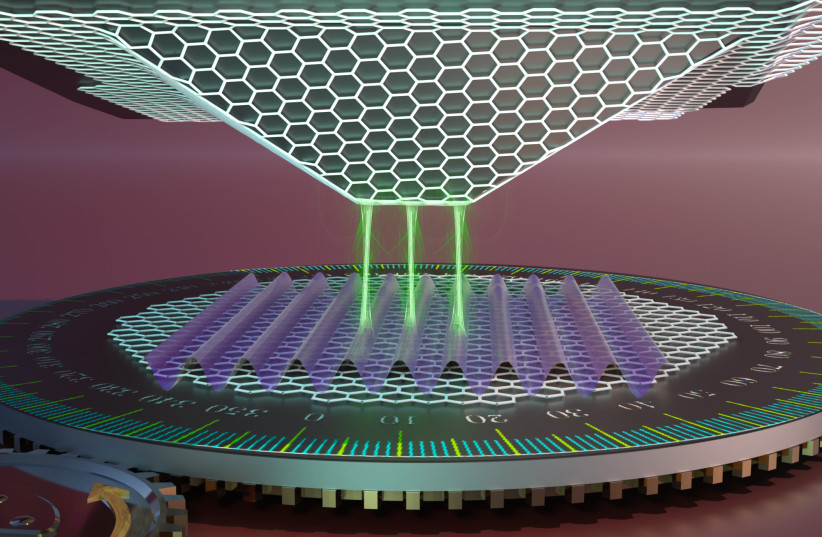Weizmann Institute scientists discover tool for the science of twistronics
The discovery might be essential for emerging technologies because it allows access to an unprecedented spectrum of new quantum interfaces.
One of the striking aspects of the quantum world is that a particle is also a wave. Quantum particles exist in many places and forms at the same time.
In a study titled “The Quantum Twisting Microscope” just published in the journal Nature, researchers from the Weizmann Institute of Science in Rehovot made use of this property to develop a new type of tool – the quantum twisting microscope (QTM) – that can create novel quantum materials while simultaneously gazing into the most fundamental nature of their electrons. The study’s findings may be used to create electronic materials with unprecedented functionalities.
Quantum twisting microscope
The QTM involves the “twisting” or rotating of two single-atom layers of material with respect to one another. In recent years, such twisting has become a major source of discoveries. It began with the discovery that placing two layers of graphene – one-atom-thick crystalline sheets of carbon – atop the other with a slight relative twist angle leads to an “atomic sandwich” with unexpected new properties.
The twist angle turned out to be the most critical parameter for controlling the behavior of electrons. Changing it by merely one-tenth of a degree could transform the material from an exotic superconductor into an unconventional insulator. But critical as it is, this parameter is also the hardest to control. By and large, twisting two layers to a new angle requires building a new “sandwich” from scratch, a process that is very long and tedious.
“Our original motivation was to solve this problem by building a machine that could continuously twist any two materials with respect to one another, readily producing an infinite range of novel materials,” said Prof. Shahal Ilani of Weizmann’s Condensed Matter Physics Department. “However, while building this machine, we discovered that it can also be turned into a very powerful microscope, capable of seeing quantum electronic waves in ways that were unimaginable before.”
The Weizmann researchers have already applied their microscope to studying the properties of several key quantum materials at room temperature and are now gearing up to conduct new experiments at temperatures of a few kelvins, the standard unit of thermodynamic temperature. At these temperatures, some of the most exciting quantum mechanical effects are known to occur.
Pictures have long played a central role in scientific discovery. Light microscopes and telescopes routinely provide images that allow scientists to gain a deeper understanding of biological and astrophysical systems. Taking pictures of electrons inside materials, on the other hand, has for many years been extremely difficult because of the infinitesimally small dimensions involved.
New Quantum Microscope Recording the Flow of Light from Technion
THIS CHANGED some 40 years ago with the invention of the scanning tunneling microscope, which earned its developers the 1986 Nobel Prize in Physics. This microscope uses an atomically sharp needle to scan the surface of a material, measuring the electric current and gradually building an image of the distribution of electrons in the sample.
“Many different scanning probes have been developed since this invention, each measuring a different electronic property, but all of them measure these properties at one location at a time. So, they mostly see electrons as particles, and can only indirectly learn about their wave nature,” added Prof. Ady Stern from the Weizmann Institute who took part in the study along with three other theoretical physicists from the same department.
“As it turned out, the tool that we have built can visualize the quantum electronic waves directly, giving us a way to unravel the quantum dances they perform inside the material,” Stern said.Alon Inbar, a lead author on the paper, said, “The trick for seeing quantum waves is to spot the same electron in different locations at the same time. The measurement is conceptually similar to the famous two-slit experiment, which was used a century ago to prove for the first time that electrons in quantum mechanics have a wave nature.”
Dr. John Birkbeck, another lead author, said, “The only difference is that we perform such an experiment at the tip of our scanning microscope.”
To achieve this, the researchers replaced the atomically sharp tip of the scanning tunneling microscope with a tip that contains a flat layer of a quantum material such as a single layer of graphene. When this layer is brought into contact with the surface of the sample of interest, it forms a two-dimensional interface across that electrons can tunnel at many different locations. Quantum mechanically, they tunnel in all locations simultaneously, and the tunneling events at different locations interfere with each other. This interference allows an electron to tunnel only if its wave functions on both sides of the interface match exactly.
“To see a quantum electron, we have to be gentle,” Ilani said. “If we don’t ask it, the rude question ‘Where are you?’ but instead provide it with multiple routes to cross into our detector without us knowing where it actually crossed, we allow it to preserve its fragile wave-like nature.”
“Our microscope will give scientists a new kind of ‘lens’ for observing and measuring the properties of quantum materials,” said Jiewen Xiao, another lead author.
Peering so deeply into the quantum world can help reveal fundamental truths about nature. In the future, it might also have a tremendous effect on emerging technologies. The QTM will provide researchers with access to an unprecedented spectrum of new quantum interfaces, as well as new “eyes” for discovering quantum phenomena within them.
THIS PAGE WAS POSTED BY SPUTNIK ONE OF THE SPUTNIKS ORBIT BLOG


No comments:
Post a Comment
Stick to the subject, NO religion, or Party politics